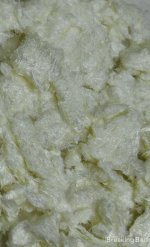We have improved the technology and confidently obtain very high yields.
I easily obtain 2-amino-5-chlorobenzophenone from 4-chloroaniline and benzoyl chloride, which are very easy to synthesize myself. The yield based on 4-chloroaniline is 68% of 2-amino-5-chlorobenzophenone (melting point at ~ 96-101 ° C)
Having obtained 2-amino-5-chlorobenzophenone, I place it in a reactor with an inert atmosphere with a dry solvent and dropwise add chloroacetyl chloride with reflux stirring and cool. After cooling, I wash the separated crystals with a solvent and recrystallize in ethanol + water. Having obtained beautiful needles of 2-(2-chloroacetamido)-5-chlorobenzophenone with a melting point of 123-126 ° C...
The yield is 82%
2-(2-chloroacetamido)-5-chlorobenzophenone must be converted to normethyldiazepam.
This is done very simply... 2-(2-chloroacetamido)-5-chlorobenzophenone is placed in the solvent and ammonium chloride is added to it, then Urotropin. All this is put on reflux with stirring, after which normethyldiazepam is isolated and crystallized. The yield of normethyldiazepam was 76% with a melting point of 217-219 ° C.
The next step is to obtain Thionordiazepam.
To do this, pyridine is poured into a reactor equipped with a calcium chloride tube. While stirring, I turn on the heating and when the desired temperature is reached, I add Tetraphosphorus Decasulfide... stir for 10 minutes and add Normethyldiazepam in parts. After reflux... cool and neutralize.
Filter and recrystallize Thionordiazepam with a yield of 68% having a melting point of 240-250 ° C
The last stage is the simplest.
Thionordiazepam > Alprazolam
I place Thionordiazepam in a reactor equipped with a calcium chloride tube and pour dry n-butanol into the reactor and add acetylhydrazide. Reflux, distillation of the solvent and isolation of Alprazolam. I received a white translucent hydrate of Alprazolam, with a melting point of ~ 120 ° C after recrystallization in water.
But my task was to obtain anhydrous Alprazolam. I dry the hydrate at 65° for 24 hours and obtain anhydrous alprazolam (the crystals have lost their shine), with a melting point on the thermometer of 229-232°C.
If it is recrystallized from anhydrous solvent, we will obtain crystals in the form of loose long needles.
The yield of dry alprazolam was ~75%
The formation of alprazolam hydrate is proven in the IR spectrum by the presence of a wide OH band at 3420 cm - 1.
C17H13ClN4 • 2H2O (MW = 344.80).
Another form (possibly a solvate) crystallizes from dioxane with a melting point of 236-239°C,
and from chloroform-methanol with a melting point of 240-243°C, small needles...
I have a complete technology for obtaining alprazolam with high yield and low cost and available reagents that are easily available in the public domain.
I am happy to sell such technology for $25,000
Remember that 1kg of alprazolam will give you 500k tablets with a dosage of 2mg, which cost at least 3 to 5 dollars on the black market. 1,5-2,5m $
The cost of such a kilogram in production is no more than 300-400$. A large amount of solvents are regenerated and reused.



